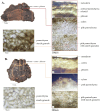Uncovering the poisonous aconitine containing plants in homemade herbal liquor using a convergent approach
- PMID: 40854923
- PMCID: PMC12378339
- DOI: 10.1038/s41598-025-14764-9
Uncovering the poisonous aconitine containing plants in homemade herbal liquor using a convergent approach
Abstract
Human exposure to toxic plants is a global concern, with numerous reported cases of accidental poisoning. In this study, a patient experienced poisoning after inadvertently consuming an herbal preparation preserved in alcohol. The patient exhibited characteristic electrocardiogram abnormalities, prompting further investigation into the toxic plant responsible. A relative provided the suspected herbal sample for identification. Symptomatic treatment was administered, successfully stabilizing the patient. Given the suspicion of aconitine toxicity-despite the absence of naturally occurring Aconitum species in Thailand-a multi-approach methodology was employed to identify the plant source. Macroscopic and microscopic analyses were performed to characterize the morphological and histological features of the specimens. Organoleptic assessment revealed blackish-brown, shrunken surfaces with longitudinal wrinkles and a pale alcoholic-like odor. Microscopic examination identified three major structural layers: metaderm and cortex, vascular tissues, and a parenchyma-rich central pith, consistent with Aconitum storage roots. Chemical identification using thin-layer chromatography (TLC) compared the patient samples (SX1 and SX2) with standard aconitine and Aconitum crude drugs (AC1-AC5). The TLC chromatograms confirmed the presence of aconitine in SX1 and SX2, as evidenced by matching Rf values and characteristic color reactions. Further molecular analysis utilizing DNA barcoding targeted the trnH-psbA region to determine the genetic origin of the specimens. PCR successfully amplified DNA from SX1, SX2, and Aconitum reference samples, generating approximately 150 bp amplicons. BLAST analysis revealed a 99.07% sequence identity with Aconitum species, and phylogenetic analysis clustered the patient specimens with authenticated Aconitum species. Given that Aconitum, Delphinium, and Consolida species are not naturally distributed in Thailand, this case highlights the risks associated with imported medicinal plants containing aconitine. The integration of macroscopic, microscopic, chemical, and molecular techniques provided definitive identification of the toxic plant material. These findings underscore the importance of public health initiatives to raise awareness of aconitine poisoning and the need for regulatory measures to ensure the safe use of medicinal plants.
Keywords: Aconitine; DNA barcode; Identification; Monkshood; Toxicity.
© 2025. The Author(s).
Conflict of interest statement
Declarations. Competing interests: The authors declare no competing interests. Ethical approval: This study was approved by the Institutional Review Board (IRB) of the Faculty of Medicine, Chiang Mai University, which reviewed the study protocol and determined that it met the criteria for exemption under the research exemption category (EXEMPTION 0538/2025), with the assigned protocol number MED-2568-0538. The written informed consent was obtained from the patient for the publication of anonymized clinical information and for the use of plant material used in the preparation of homemade herbal liquor in this study. Both the exemption certificate and the signed informed consent were obtained and archived at the Cardiovascular Medicine Unit, Department of Internal Medicine, Faculty of Medicine, Chiang Mai University. The study was conducted in full accordance with the principles outlined in the Declaration of Helsinki.
Figures





Similar articles
-
Prescription of Controlled Substances: Benefits and Risks.2025 Jul 6. In: StatPearls [Internet]. Treasure Island (FL): StatPearls Publishing; 2025 Jan–. 2025 Jul 6. In: StatPearls [Internet]. Treasure Island (FL): StatPearls Publishing; 2025 Jan–. PMID: 30726003 Free Books & Documents.
-
Recent Advances in Analytical Methods for Aconitine Alkaloid in Natural Products: A Systematic Review.Phytochem Anal. 2025 Aug;36(6):1621-1648. doi: 10.1002/pca.70003. Epub 2025 Jul 1. Phytochem Anal. 2025. PMID: 40592742 Review.
-
A systematic review of pharmacokinetic studies on herbal drug Fuzi: Implications for Fuzi as personalized medicine.Phytomedicine. 2018 May 15;44:187-203. doi: 10.1016/j.phymed.2018.03.001. Epub 2018 Mar 1. Phytomedicine. 2018. PMID: 29526584
-
The effect of sample site and collection procedure on identification of SARS-CoV-2 infection.Cochrane Database Syst Rev. 2024 Dec 16;12(12):CD014780. doi: 10.1002/14651858.CD014780. Cochrane Database Syst Rev. 2024. PMID: 39679851 Free PMC article.
-
First Report of Albugo ipomoeae-panduratae Causing White Rust on Ivyleaf morningglory (Ipomoea hederacea) in Iowa.Plant Dis. 2025 Jul 8. doi: 10.1094/PDIS-12-24-2570-PDN. Online ahead of print. Plant Dis. 2025. PMID: 40627016
References
-
- Fuchs, J. et al. Acute plant poisoning: Analysis of clinical features and circumstances of exposure. Clin. Toxicol.49, 671–680 (2011). - PubMed
-
- Ng, W. et al. Poisoning by toxic plants in Hong kong: A 15-year review. Hong Kong Med. J.25, 102 (2019). - PubMed
-
- Mezzasalma, V. et al. Poisonous or non-poisonous plants? DNA-based tools and applications for accurate identification. Int. J. Legal Med.131, 1–19 (2017). - PubMed
Publication types
MeSH terms
Substances
LinkOut - more resources
Full Text Sources
Research Materials

